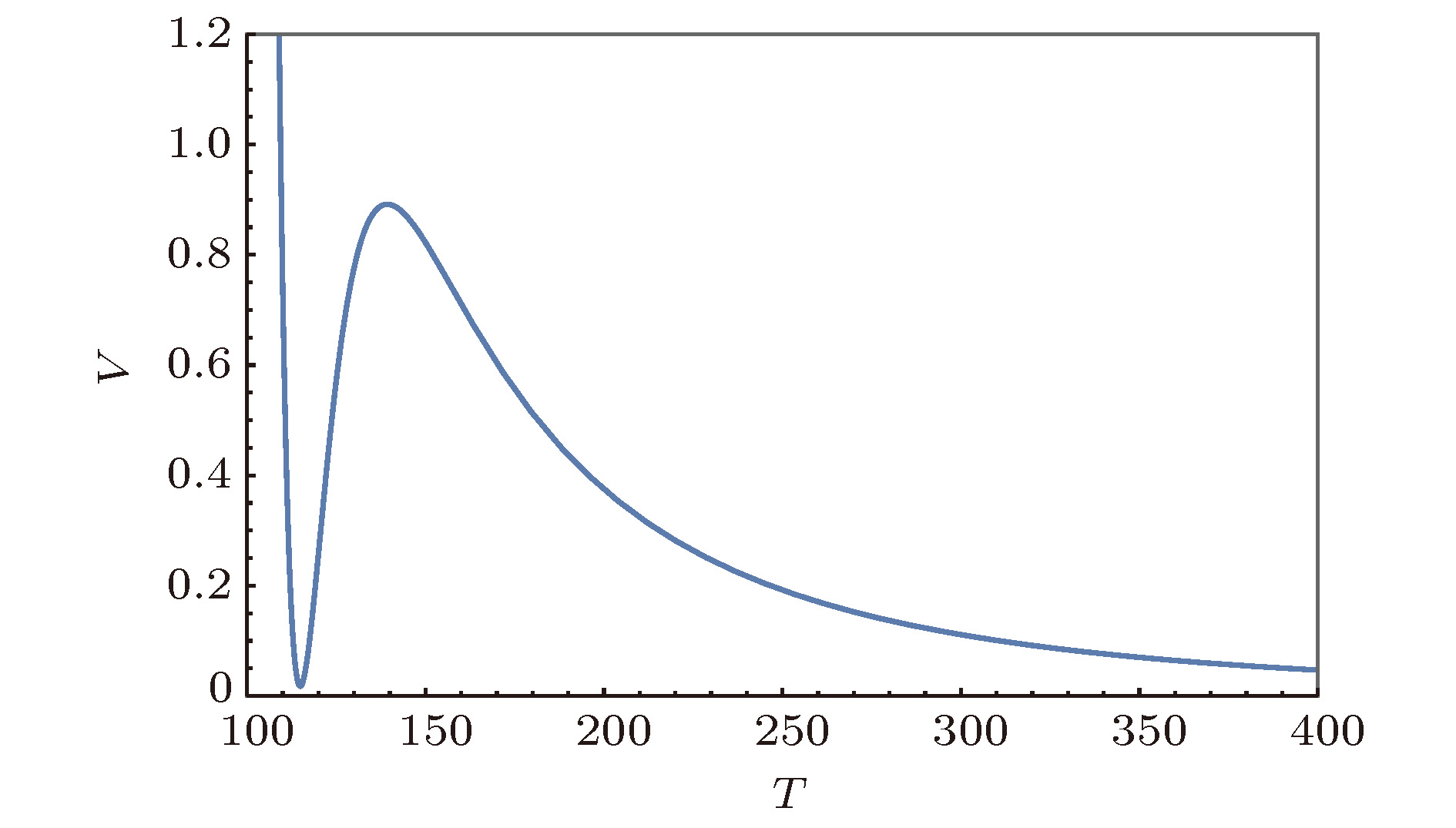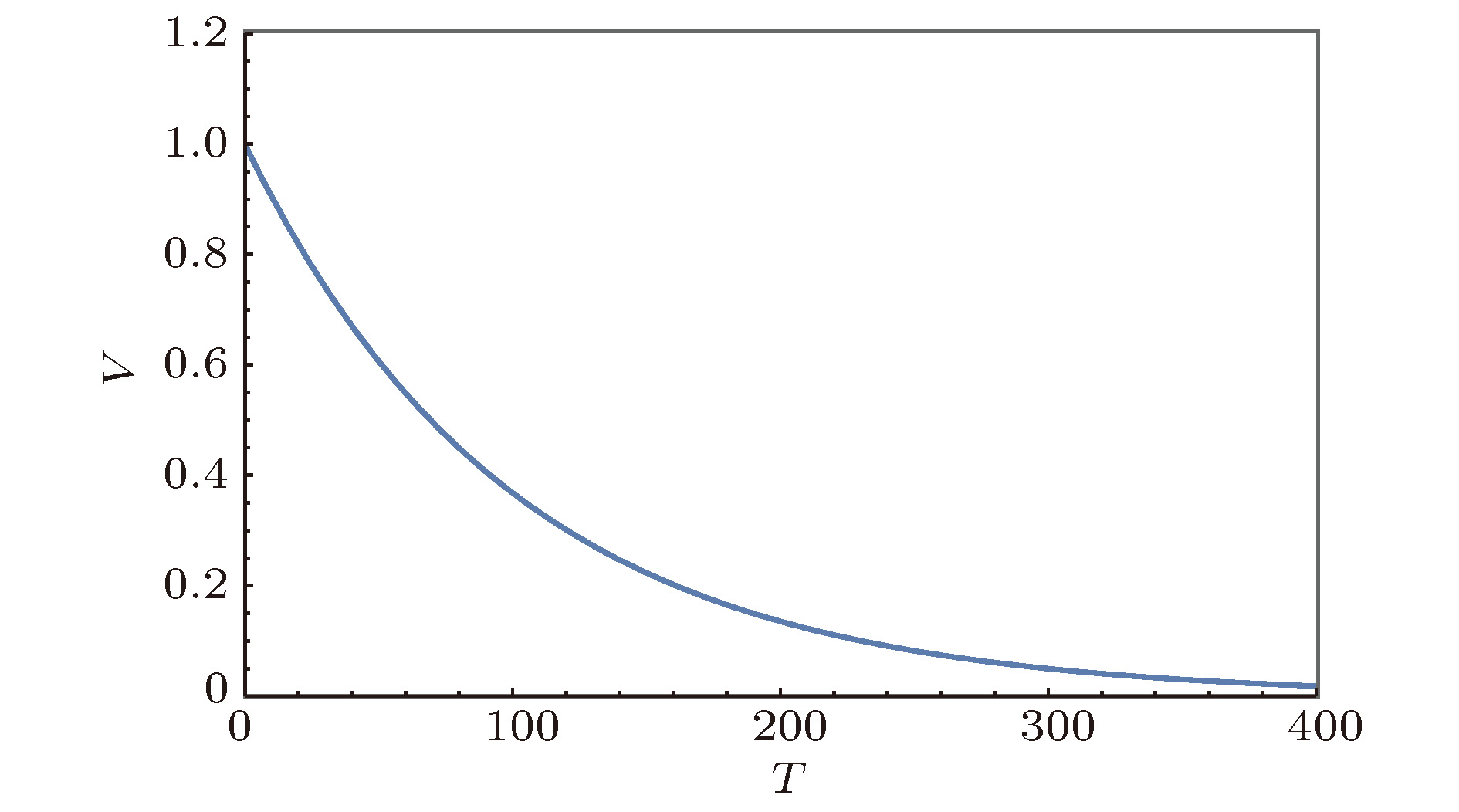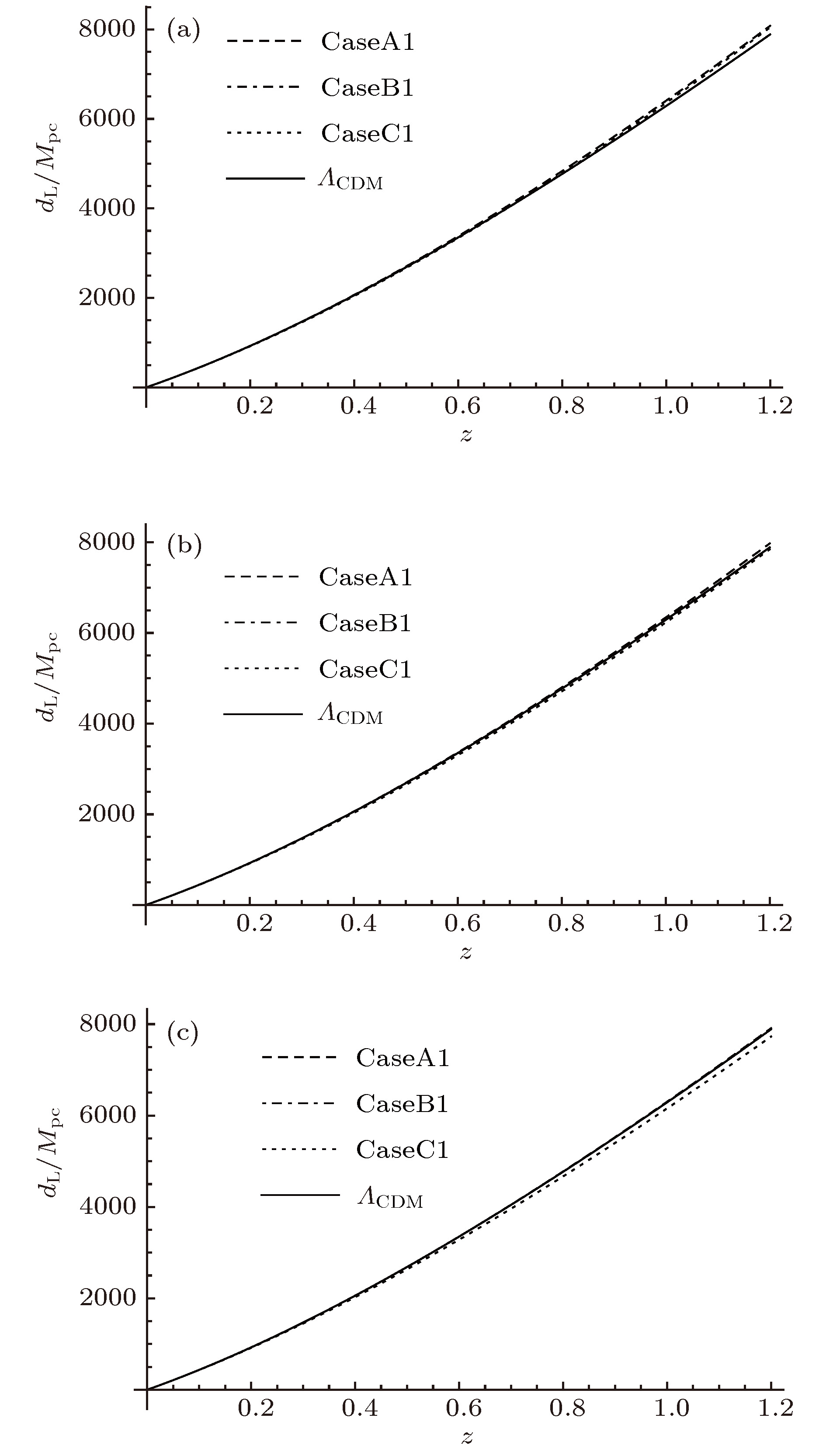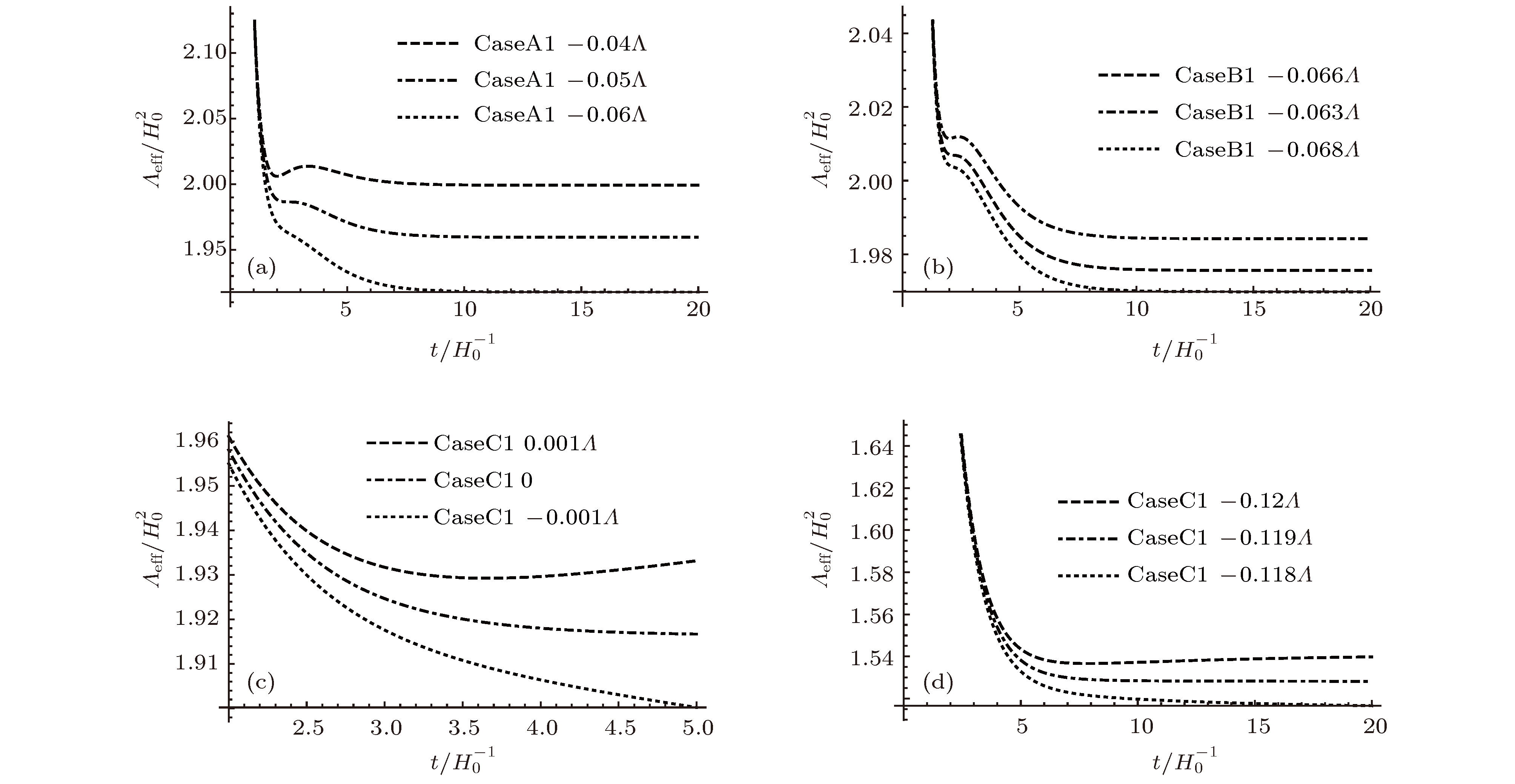-
Recently, Vafa et al. proposed two string swampland criteria, and studying the constraints imposed by the two string swampland criteria on cosmology, they found that the inflationary models are generally difficult to be compatible with these two criteria. Applying these two criteria to the accelerated expansion of the universe during the current period, it was found that the specific quintessence model can satisfy these constraints while satisfying the constraints imposed by the current observations. Applying the gravitational theory of large scale Lorentz violation to cosmology, the vacuum energy density is not the only cause of the accelerated expansion of the universe. The large scale Lorentz violation combined with the cosmological constant term results in the observed accelerated expansion of the late universe. The vacuum energy density is a bit like a naked cosmological constant. The equivalent energy density considering the large scale Lorentz violation effect is the effective cosmological constant that determines the evolution of the universe. In this way, we find that the negative cosmological constant in the string landscape can also accelerate the expansion of the universe, and compared with the
$ {\varLambda _{{\rm{CDM}}}}$ model, it leads to a cosmological constant as an effective vacuum energy density. Effective vacuum energy density behaves as a monotonically decreasing quintessence potential energy for the string landscape, for most of the naked positive vacuum energy densities in the swampland, the evolution of effective cosmological constant with time will show a local minimum. Comparing the calculated results of the distance modulus withthe astronomical observations, we can obtain that a negative cosmological constant also accelerates the expansion of the universe. Thus, the vacuum energy density derived from the string landscape will give quintessence potential that satisfies the swampland criterion, while the evolution of vacuum energy density given by the swampland model of the metastable dS vacuum is not quintessence potential, so it cannot satisfy the second de Sitter criterion. Therefore, the effective potential leading to the accelerated expansion of the late universe can only come from the string landscape, which is naturally UV completion. Therefore, it gives that the accelerated expansion of the late universe is the feature of early quantum gravity. It is not necessary to use the metastable de Sitter vacuum to explain the accelerated expansion of the late universe. The difficulty of incompatibility between the swampland model and the accelerated expansion of the late universe caused by the swampland conjecture will be eliminated.[1] Douglas M R 2003 J. High Energ. Phys. 2003 046
[2] Douglas M R 2002 Unity from Duality: Gravity, Gauge Theory and Strings (Berlin: Springer-Verlag) pp455–475
[3] Susskind L 2003 arXiv: hep-th/0302219[hep-th]
[4] Vafa C 2005 arXiv: hep-th/0509212 [hep-th]
[5] Ooguri H, Vafa C 2007 Nucl. Phys. B 766 21
 Google Scholar
Google Scholar
[6] Agrawal P, Obied G, Steinhardt P, Vafa C 2018 Phys. Lett. B 784 271
 Google Scholar
Google Scholar
[7] Obied G, Ooguri H, Spodyneiko L, Vafa C 2018 arXiv: 1806.08362[hep-th]
[8] Brennan T D, Carta F, Vafa C 2017 arXiv: 1711.00864[hep-th]
[9] Kachru S, Kallosh R, Linde A, Trivedi S P 2003 Phys. Rev. D 68 046005
 Google Scholar
Google Scholar
[10] Coleman S R, Glashow S L 1999 Phys. Rev. D 59 116008
 Google Scholar
Google Scholar
[11] Colladay D, Kostelecky V A 1998 Phys. Rev. D 58 116002
 Google Scholar
Google Scholar
[12] Shen J Y, Xue X 2018 arXiv: 1802.03502[gr-qc]
[13] Wu Y W, Xue X, Yang L X, Yuan T 2016 Chin. Sci. Bull. 10 1360
[14] Wu Y W, Xue X, Yang L X, Yuan T 2015 arXiv: 1510.00814v3[gr-qc]
[15] 魏文叶, 申佳音, 吴奕暐, 杨礼想, 薛迅, 阮自强 2017 66 130301
 Google Scholar
Google Scholar
Wei W Y, Shen J Y, Wu Y W, Yang L X, Xue X, Yuan T C 2017 Acta. Phys. Sin. 66 130301
 Google Scholar
Google Scholar
[16] 杨礼想, 吴奕暐, 魏文叶, 薛迅, 阮自强 2017 科学通报 62 944
Yang L X, Wu Y W, Wei W Y, Xue X, Yuan T C 2017 Chin. Sci. Bull. 62 944
[17] Wu Y W, Xue X 2016 J. East China Normal Univ. 3 76
[18] Castelvecchi D, Witze A https://www.nature.com/news/einstein-s-gravitational-waves-found-at-last-1.19361 [2019-3-15]
[19] Abbott B P 2016 Phys. Rev. Lett. 116 061102
 Google Scholar
Google Scholar
[20] Svitil K, Allen K, Kupec I, Ricci F, Milde S https://phys.org/news/2016-02-gravitational-years-einstein.html [2019-4-23]
[21] Deser S, Woodard R P 2019 arXiv: 1902.08075 [gr-qc]
[22] Rajvanshi M P, Chakraborty T, Bagla J S 2018 arXiv: 1803.04267 [physics.pop-ph]
[23] Cai R G, Khimphun S, Lee B H, Sun S, Tumurtushaa G, Zhang Y L 2018 arXiv: 1812.11105 [hep-th]
[24] Dimopoulos K, Markkanen T 2018 arXiv: 1807.04359 [astro-ph.CO]
[25] Glavan D, Prokopec T, Starobinsky A A 2018 Eur. Phys. J. C 78 371
 Google Scholar
Google Scholar
[26] Dinda B R 2019 arXiv: 1904.10418 [astro-ph.CO]
[27] Dimakis N, Paliathanasis A, Terzis P A, Christodoulakis T 2019 arXiv: 1904.09713 [gr-qc]
[28] Johnson J P, Shankaranarayanan S 2019 arXiv: 1904.07608 [astro-ph.CO]
[29] Rani S, Jawad A, Bamba K, Malik I U 2019 arXiv: 1904.04633 [physics.gen-ph]
[30] Li X L, Shafieloo A, Sahni V, Starobinsky A A 2019 arXiv: 1904.03790 [astro-ph.CO]
[31] Zhang H C, Xu L X 2019 arXiv: 1904.03545 [gr-qc]
[32] Nielsen J T, Guffanti A, Sarkar S 2016 Sci. Rep. 6 219
[33] Lukierski J, Nowicki A 2003 Int. J. Mod. Phys. A 18 7
 Google Scholar
Google Scholar
-
图 3
${\cal{K}}\left( {{t_0}} \right) = {H_0}\left( {\sqrt {1 - \dfrac{{\varLambda - {\varLambda _0}}}{{3{H_0}^2}}} - 1} \right)$ ,${w_0} = - 0.88$ 时哈勃常数随时间的演化 (a)${\varLambda _0} = - {\rm{0}}.{\rm{2}}\varLambda $ ; (b)${\varLambda _0} = 0$ ; (c)${\varLambda _0} = {\rm{0}}.{\rm{2}}\varLambda $ Figure 3. The Hubble constant evolves with the time when
${w_0} = - 0.88$ ,${\cal{K}}\left( {{t_0}} \right) = {H_0}\left( {\sqrt {1 - \dfrac{{\varLambda - {\varLambda _0}}}{{3{H_0}^2}}} - 1} \right)$ : (a)${\varLambda _0} = - {\rm{0}}.{\rm{2}}\varLambda $ ; (b)${\varLambda _0} = 0$ ; (c)$ {\varLambda _0} = {\rm{0}}.{\rm{2}}\varLambda $ .图 4
${\cal{K}}\left( {{t_0}} \right) = - {H_0}\left( {\sqrt {1 - \dfrac{{\varLambda - {\varLambda _0}}}{{3{H_0}^2}}} + 1} \right)$ ,${w_0} = - 0.88$ 时哈勃常数随时间的演化 (a)${\varLambda _0} = - {\rm{0}}.{\rm{2}}\varLambda $ ; (b)${\varLambda _0} = 0$ ; (c)${\varLambda _0} = {\rm{0}}.{\rm{2}}\varLambda $ Figure 4. The Hubble constant evolves with the time when
${w_0} = - 0.88$ ,${\cal{K}}\left( {{t_0}} \right) = - {H_0}\left( {\sqrt {1 - \dfrac{{\varLambda - {\varLambda _0}}}{{3{H_0}^2}}} + 1} \right)$ : (a)${\varLambda _0} = - {\rm{0}}.{\rm{2}}\varLambda $ ; (b)${\varLambda _0} = 0$ ; (c)$ {\varLambda _0} = {\rm{0}}.{\rm{2}}\varLambda $ .图 5
${\cal{K}}\left( {{t_0}} \right) = {H_0}\left( {\sqrt {1 - \dfrac{{\varLambda - {\varLambda _0}}}{{3{H_0}^2}}} - 1} \right)$ ,${w_0} = - 0.88$ 时${\cal{K}}$ 随时间的演化 (a)${\varLambda _0} = - {\rm{0}}.{\rm{2}}\varLambda $ ; (b)${\varLambda _0} = 0$ ; (c)${\varLambda _0} = {\rm{0}}.{\rm{2}}\varLambda $ Figure 5.
${\cal{K}}$ evolves with the time when${w_0} = - 0.88$ ,${\cal{K}}\left( {{t_0}} \right) = {H_0}\left( {\sqrt {1 - \dfrac{{\varLambda - {\varLambda _0}}}{{3{H_0}^2}}} - 1} \right)$ : (a)${\varLambda _0} = - {\rm{0}}.{\rm{2}}\varLambda $ ; (b)${\varLambda _0} = 0$ ; (c)${\varLambda _0} = {\rm{0}}.{\rm{2}}\varLambda $ .图 6
${\cal{K}}\left( {{t_0}} \right) = - {H_0}\left( {\sqrt {1 - \dfrac{{\varLambda - {\varLambda _0}}}{{3{H_0}^2}}} + 1} \right)$ ,${w_0} = - 0.88$ 时${\cal{K}}$ 随时间的演化 (a)${\varLambda _0} = - {\rm{0}}.{\rm{2}}\varLambda $ ; (b)${\varLambda _0} = 0$ ; (c)${\varLambda _0} = {\rm{0}}.{\rm{2}}\varLambda $ Figure 6.
${\cal{K}}$ evolves with the time when${w_0} = - 0.88$ ,${\cal{K}}\left( {{t_0}} \right) = - {H_0}\left( {\sqrt {1 - \dfrac{{\varLambda - {\varLambda _0}}}{{3{H_0}^2}}} + 1} \right)$ : (a)${\varLambda _0} = - {\rm{0}}.{\rm{2}}\varLambda $ ; (b)${\varLambda _0} = 0$ ; (c)${\varLambda _0} = {\rm{0}}.{\rm{2}}\varLambda $ .图 7
${\cal{K}}\left( {{t_0}} \right) = {H_0}\left( {\sqrt {1 - \dfrac{{\varLambda - {\varLambda _0}}}{{3{H_0}^2}}} - 1} \right)$ ,${w_0} = - 0.88$ 时光度距离随红移的演化 (a)${\varLambda _0} = - {\rm{0}}.{\rm{2}}\varLambda $ ; (b)${\varLambda _0} = 0$ ; (c)${\varLambda _0} = {\rm{0}}.{\rm{2}}\varLambda $ Figure 7. The luminosity distance evolves with the redshift when
${w_0} = - 0.88$ ,${\cal{K}}\left( {{t_0}} \right) = {H_0}\left( {\sqrt {1 - \dfrac{{\varLambda - {\varLambda _0}}}{{3{H_0}^2}}} - 1} \right)$ : (a)${\varLambda _0} = - {\rm{0}}.{\rm{2}}\varLambda $ ; (b)${\varLambda _0} = 0$ ; (c)${\varLambda _0} = {\rm{0}}.{\rm{2}}\varLambda $ .图 8
${\cal{K}}\left( {{t_0}} \right) = - {H_0}\left( {\sqrt {1 - \dfrac{{\varLambda - {\varLambda _0}}}{{3{H_0}^2}}} + 1} \right)$ ,${w_0} = - 0.88$ 时光度距离随红移的演化 (a)${\varLambda _0} = - {\rm{0}}.{\rm{2}}\varLambda $ ; (b)${\varLambda _0} = 0$ ; (c)${\varLambda _0} = {\rm{0}}.{\rm{2}}\varLambda $ Figure 8. the luminosity distance evolves with the redshift when
${w_0} = - 0.88$ ,${\cal{K}}\left( {{t_0}} \right) = - {H_0}\left( {\sqrt {1 - \dfrac{{\varLambda - {\varLambda _0}}}{{3{H_0}^2}}} + 1} \right)$ (a)${\varLambda _0} = - {\rm{0}}.{\rm{2}}\varLambda $ ; (b)${\varLambda _0} = 0$ ; (c)${\varLambda _0} = {\rm{0}}.{\rm{2}}\varLambda $ .图 9
${\cal{K}}\left( {{t_0}} \right) = {H_0}\left( {\sqrt {1 - \dfrac{{\varLambda - {\varLambda _0}}}{{3{H_0}^2}}} - 1} \right)$ ,${w_0} = - 0.88$ 时距离模数测量值与理论期望值的对比 (a)${\varLambda _0} = - {\rm{0}}.{\rm{2}}\varLambda $ ; (b)${\varLambda _0} = 0$ ; (c)${\varLambda _0} = {\rm{0}}.{\rm{2}}\varLambda $ Figure 9. Comparison of the measured distance moduluswith its expected value when
${\cal{K}}\left( {{t_0}} \right) = {H_0}\left( {\sqrt {1 - \dfrac{{\varLambda - {\varLambda _0}}}{{3{H_0}^2}}} - 1} \right)$ ,${w_0} = - 0.88$ : (a)${\varLambda _0} = - {\rm{0}}.{\rm{2}}\varLambda $ ; (b)${\varLambda _0} = 0$ ; (c)$ {\varLambda _0} = {\rm{0}}.{\rm{2}}\varLambda$ 图 10
${\cal{K}}\left( {{t_0}} \right) = - {H_0}\left( {\sqrt {1 - \dfrac{{\varLambda - {\varLambda _0}}}{{3{H_0}^2}}} + 1} \right)$ ,${w_0} = - \dfrac{8}{9}$ 时距离模数实验测量值与理论期望值的对比 (a)${\varLambda _0} = - 0.2\varLambda $ ; (b)${\varLambda _0} = 0$ ; (c)${\varLambda _0} = {\rm{0}}.{\rm{2}}\varLambda $ Figure 10. Comparison of the measured distance moduluswith its expected value when
${\cal{K}}\left( {{t_0}} \right)\!=\!- {H_0}\left(\!{\sqrt {1\!-\!\dfrac{{\varLambda\!-\!{\varLambda _0}}}{{3{H_0}^2}}}\!+\!1}\!\right)$ ,${w_0} = - \dfrac{8}{9}$ : (a)${\varLambda _0} = - 0.2\varLambda $ ; (b)${\varLambda _0} = 0$ ; (c)$ {\varLambda _0} = {\rm{0}}.{\rm{2}}\varLambda$ .图 11
${\cal{K}}\left( {{t_0}} \right) = {H_0}\left( {\sqrt {1 - \dfrac{{\varLambda - {\varLambda _0}}}{{3{H_0}^2}}} - 1} \right)$ 时${\varLambda _{{\rm{eff}}}}$ 从单调的quintessence类型到随时间的演化出现局域极小类型的转变 (a) CaseA1; (b) CaseB1; (c) CaseC1,${w_0} = - 1$ ; (d) CaseC1,${w_0} = - \dfrac{8}{9}$ Figure 11.
${\varLambda _{{\rm{eff}}}}$ shifts from a monotonically decreasing quintessence type to a local minimal type transition with time evolution when${\cal{K}}\left( {{t_0}} \right) = {H_0}\left( {\sqrt {1 - \dfrac{{\varLambda - {\varLambda _0}}}{{3{H_0}^2}}} - 1} \right)$ (a) CaseA1; (b) CaseB1; (c) CaseC1,${w_0} = - 1$ ; (d) CaseC1,${w_0} = - \dfrac{8}{9}$ .图 12
${\cal{K}}\left( {{t_0}} \right) = - {H_0}\left( {\sqrt {1 - \dfrac{{\varLambda - {\varLambda _0}}}{{3{H_0}^2}}} + 1} \right)$ 时${\varLambda _{{\rm{eff}}}}$ 从单调的quintessence类型到随时间的演化出现局域极小类型的转变 (a) CaseA2; (b) CaseB2; (c) CaseC2,${w_0} = - 1$ ; (d) CaseC2,${w_0} = - \dfrac{8}{9}$ Figure 12.
${\varLambda _{{\rm{eff}}}}$ shifts from a monotonically decreasing quintessence type to a local minimal type transition with time evolution when${\cal{K}}\left( {{t_0}} \right) = - {H_0}\left( {\sqrt {1 - \dfrac{{\varLambda - {\varLambda _0}}}{{3{H_0}^2}}} + 1} \right)$ (a) CaseA2; (b) CaseB2; (c) CaseC2,${w_0} = - 1$ ; (d) CaseC2,${w_0} = - \dfrac{8}{9}$ .表 1 Lorentz破缺宇宙学的几种模型
Table 1. Proposed models of Lorentz violation cosmology.
${\cal{K}}\left( {{t_0}} \right)$的值 ${\cal{K}}\left( t \right)$的方程 CaseA1 ${\cal{K}}\left( {{t_0}} \right) = {H_0}\left( {\sqrt {1 - \dfrac{{\varLambda - {\varLambda _0}}}{{3{H_0}^2}}} - 1} \right)$ $H\left( t \right){\cal{K}}\left( t \right) + {\dot {\cal{K}}}\left( t \right) = \dfrac{1}{3}\left( {{\varLambda _0} - \varLambda } \right);$ CaseA2 ${\cal{K}}\left( {{t_0}} \right) = - {H_0}\left( {\sqrt {1 - \dfrac{{\varLambda - {\varLambda _0}}}{{3{H_0}^2}}} + 1} \right)$ $H\left( t \right){\cal{K}}\left( t \right) + \dot {\cal{K}}\left( t \right) = \dfrac{1}{3}\left( {{\varLambda _0} - \varLambda } \right);$ CaseB1 ${\cal{K}}\left( {{t_0}} \right) = {H_0}\left( {\sqrt {1 - \dfrac{{\varLambda - {\varLambda _0}}}{{3{H_0}^2}}} - 1} \right)$ $\dot {\cal{K}} + 2H{\cal{K}} + \dfrac{1}{2}{{\cal{K}}^2} = \dfrac{1}{2}\left( {{\varLambda _0} - \varLambda } \right);$ CaseB2 ${\cal{K}}\left( {{t_0}} \right) = - {H_0}\left( {\sqrt {1 - \dfrac{{\varLambda - {\varLambda _0}}}{{3{H_0}^2}}} + 1} \right)$ $\dot {\cal{K}} + 2H{\cal{K}} + \dfrac{1}{2}{{\cal{K}}^2} = \dfrac{1}{2}\left( {{\varLambda _0} - \varLambda } \right);$ CaseC1 ${\cal{K}}\left( {{t_0}} \right) = {H_0}\left( {\sqrt {1 - \dfrac{{\varLambda - {\varLambda _0}}}{{3{H_0}^2}}} - 1} \right)$ $\begin{array}{l} \left( {3{w_0} + 1} \right){{\cal{K}}^2} + \left( {6{w_0} + 4} \right)H{\cal{K}} + 2\dot {\cal{K}} = \left( {{w_0} + 1} \right){\varLambda _0}; \\ \end{array} $ CaseC2 ${\cal{K}}\left( {{t_0}} \right) = - {H_0}\left( {\sqrt {1 - \dfrac{{\varLambda - {\varLambda _0}}}{{3{H_0}^2}}} + 1} \right)$ $\begin{array}{l} \left( {3{w_0} + 1} \right){{\cal{K}}^2} + \left( {6{w_0} + 4} \right)H{\cal{K}} + 2\dot {\cal{K}} = \left( {{w_0} + 1} \right){\varLambda _0}. \\ \end{array} $ 表 2 在不同模型下有无
${\varLambda _0}$ 的临界值Table 2. Whether there are critical values of
${\varLambda _0}$ under different models${\cal{K}}\left( {{t_0}} \right)$的值 ${\varLambda _0}$的临界值 CaseA ${\cal{K}}\left( {{t_0}} \right) = {H_0}\left( {\sqrt {1 - \dfrac{{\varLambda - {\varLambda _0}}}{{3{H_0}^2}}} - 1} \right)$ $ - 0.05\varLambda $ ${\cal{K}}\left( {{t_0}} \right) = - {H_0}\left( {\sqrt {1 - \dfrac{{\varLambda - {\varLambda _0}}}{{3{H_0}^2}}} + 1} \right)$ $ - 0.187\varLambda $ CaseB ${\cal{K}}\left( {{t_0}} \right) = {H_0}\left( {\sqrt {1 - \dfrac{{\varLambda - {\varLambda _0}}}{{3{H_0}^2}}} - 1} \right)$ $ - 0.066\varLambda $ ${\cal{K}}\left( {{t_0}} \right) = - {H_0}\left( {\sqrt {1 - \dfrac{{\varLambda - {\varLambda _0}}}{{3{H_0}^2}}} + 1} \right)$ $ - 0.2144\varLambda $ CaseC (${w_0} = - 1$) ${\cal{K}}\left( {{t_0}} \right) = {H_0}\left( {\sqrt {1 - \dfrac{{\varLambda - {\varLambda _0}}}{{3{H_0}^2}}} - 1} \right)$ $0.00001\varLambda $ ${\cal{K}}\left( {{t_0}} \right) = - {H_0}\left( {\sqrt {1 - \dfrac{{\varLambda - {\varLambda _0}}}{{3{H_0}^2}}} + 1} \right)$ $0.00001\varLambda $ CaseC(${w_0} = - {8}/{9}$) ${\cal{K}}\left( {{t_0}} \right) = {H_0}\left( {\sqrt {1 - \dfrac{{\varLambda - {\varLambda _0}}}{{3{H_0}^2}}} - 1} \right)$ $0.119\varLambda $ ${\cal{K}}\left( {{t_0}} \right) = - {H_0}\left( {\sqrt {1 - \dfrac{{\varLambda - {\varLambda _0}}}{{3{H_0}^2}}} + 1} \right)$ $0.075\varLambda $ CaseC(${w_0} = - {7}/{9}$) ${\cal{K}}\left( {{t_0}} \right) = {H_0}\left( {\sqrt {1 - \dfrac{{\varLambda - {\varLambda _0}}}{{3{H_0}^2}}} - 1} \right)$ 无 ${\cal{K}}\left( {{t_0}} \right) = - {H_0}\left( {\sqrt {1 - \dfrac{{\varLambda - {\varLambda _0}}}{{3{H_0}^2}}} + 1} \right)$ $0.152\varLambda $ CaseC(${w_0} = - {2}/{3}$) ${\cal{K}}\left( {{t_0}} \right) = {H_0}\left( {\sqrt {1 - \dfrac{{\varLambda - {\varLambda _0}}}{{3{H_0}^2}}} - 1} \right)$ 无 ${\cal{K}}\left( {{t_0}} \right) = - {H_0}\left( {\sqrt {1 - \dfrac{{\varLambda - {\varLambda _0}}}{{3{H_0}^2}}} + 1} \right)$ $0.225\varLambda $ CaseC(${w_0} = - {1}/{3}$) ${\cal{K}}\left( {{t_0}} \right) = {H_0}\left( {\sqrt {1 - \dfrac{{\varLambda - {\varLambda _0}}}{{3{H_0}^2}}} - 1} \right)$ 无 ${\cal{K}}\left( {{t_0}} \right) = - {H_0}\left( {\sqrt {1 - \dfrac{{\varLambda - {\varLambda _0}}}{{3{H_0}^2}}} + 1} \right)$ $0.397\varLambda $ -
[1] Douglas M R 2003 J. High Energ. Phys. 2003 046
[2] Douglas M R 2002 Unity from Duality: Gravity, Gauge Theory and Strings (Berlin: Springer-Verlag) pp455–475
[3] Susskind L 2003 arXiv: hep-th/0302219[hep-th]
[4] Vafa C 2005 arXiv: hep-th/0509212 [hep-th]
[5] Ooguri H, Vafa C 2007 Nucl. Phys. B 766 21
 Google Scholar
Google Scholar
[6] Agrawal P, Obied G, Steinhardt P, Vafa C 2018 Phys. Lett. B 784 271
 Google Scholar
Google Scholar
[7] Obied G, Ooguri H, Spodyneiko L, Vafa C 2018 arXiv: 1806.08362[hep-th]
[8] Brennan T D, Carta F, Vafa C 2017 arXiv: 1711.00864[hep-th]
[9] Kachru S, Kallosh R, Linde A, Trivedi S P 2003 Phys. Rev. D 68 046005
 Google Scholar
Google Scholar
[10] Coleman S R, Glashow S L 1999 Phys. Rev. D 59 116008
 Google Scholar
Google Scholar
[11] Colladay D, Kostelecky V A 1998 Phys. Rev. D 58 116002
 Google Scholar
Google Scholar
[12] Shen J Y, Xue X 2018 arXiv: 1802.03502[gr-qc]
[13] Wu Y W, Xue X, Yang L X, Yuan T 2016 Chin. Sci. Bull. 10 1360
[14] Wu Y W, Xue X, Yang L X, Yuan T 2015 arXiv: 1510.00814v3[gr-qc]
[15] 魏文叶, 申佳音, 吴奕暐, 杨礼想, 薛迅, 阮自强 2017 66 130301
 Google Scholar
Google Scholar
Wei W Y, Shen J Y, Wu Y W, Yang L X, Xue X, Yuan T C 2017 Acta. Phys. Sin. 66 130301
 Google Scholar
Google Scholar
[16] 杨礼想, 吴奕暐, 魏文叶, 薛迅, 阮自强 2017 科学通报 62 944
Yang L X, Wu Y W, Wei W Y, Xue X, Yuan T C 2017 Chin. Sci. Bull. 62 944
[17] Wu Y W, Xue X 2016 J. East China Normal Univ. 3 76
[18] Castelvecchi D, Witze A https://www.nature.com/news/einstein-s-gravitational-waves-found-at-last-1.19361 [2019-3-15]
[19] Abbott B P 2016 Phys. Rev. Lett. 116 061102
 Google Scholar
Google Scholar
[20] Svitil K, Allen K, Kupec I, Ricci F, Milde S https://phys.org/news/2016-02-gravitational-years-einstein.html [2019-4-23]
[21] Deser S, Woodard R P 2019 arXiv: 1902.08075 [gr-qc]
[22] Rajvanshi M P, Chakraborty T, Bagla J S 2018 arXiv: 1803.04267 [physics.pop-ph]
[23] Cai R G, Khimphun S, Lee B H, Sun S, Tumurtushaa G, Zhang Y L 2018 arXiv: 1812.11105 [hep-th]
[24] Dimopoulos K, Markkanen T 2018 arXiv: 1807.04359 [astro-ph.CO]
[25] Glavan D, Prokopec T, Starobinsky A A 2018 Eur. Phys. J. C 78 371
 Google Scholar
Google Scholar
[26] Dinda B R 2019 arXiv: 1904.10418 [astro-ph.CO]
[27] Dimakis N, Paliathanasis A, Terzis P A, Christodoulakis T 2019 arXiv: 1904.09713 [gr-qc]
[28] Johnson J P, Shankaranarayanan S 2019 arXiv: 1904.07608 [astro-ph.CO]
[29] Rani S, Jawad A, Bamba K, Malik I U 2019 arXiv: 1904.04633 [physics.gen-ph]
[30] Li X L, Shafieloo A, Sahni V, Starobinsky A A 2019 arXiv: 1904.03790 [astro-ph.CO]
[31] Zhang H C, Xu L X 2019 arXiv: 1904.03545 [gr-qc]
[32] Nielsen J T, Guffanti A, Sarkar S 2016 Sci. Rep. 6 219
[33] Lukierski J, Nowicki A 2003 Int. J. Mod. Phys. A 18 7
 Google Scholar
Google Scholar
Catalog
Metrics
- Abstract views: 17358
- PDF Downloads: 60
- Cited By: 0
















 DownLoad:
DownLoad:

















































































































